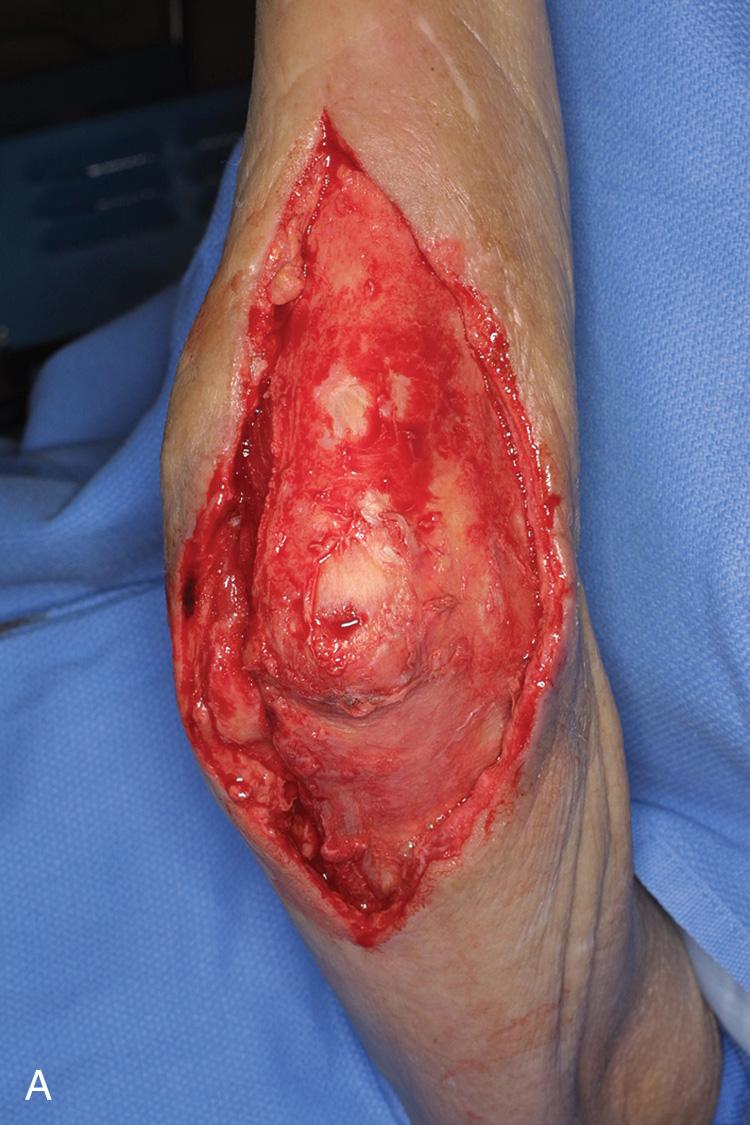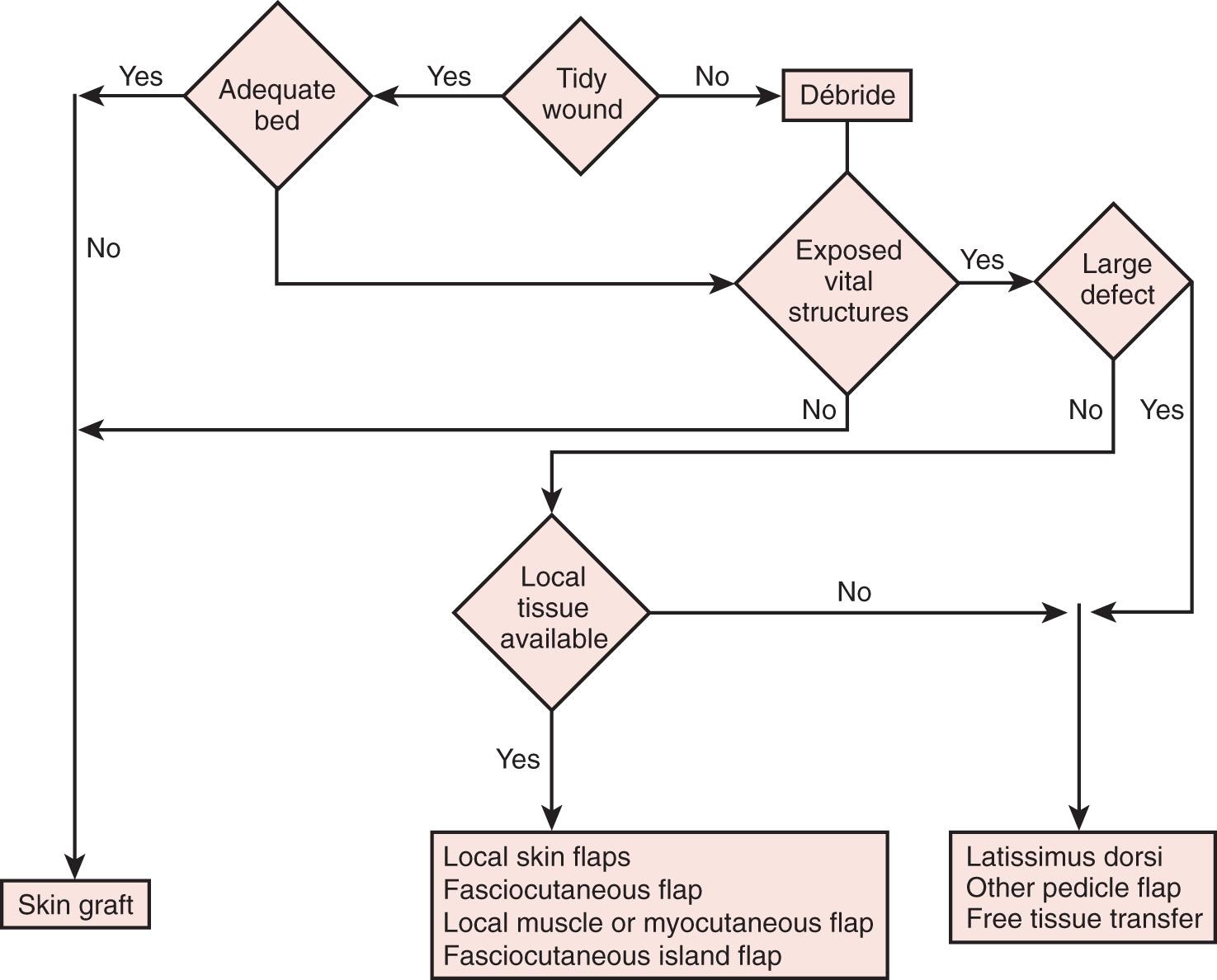Physical Address
304 North Cardinal St.
Dorchester Center, MA 02124
Difficult-to-manage soft tissue defects about the elbow occur as a result of trauma, infection, extravasation of chemotherapeutic agents, cutaneous ulceration or necrosis, and limb-sparing tumor surgery (see Chapter 58 ). Treatment options are many, and appropriate management requires careful consideration of all alternatives. Coverage choices may include primary closure, skin grafting, local cutaneous flaps, fasciocutaneous transposition flaps, island fascial or fasciocutaneous flaps, local or distant one-stage muscle or myocutaneous transposition, distant temporary pedicle flaps, and microvascular free tissue transfer. Historically, the reconstructive algorithm for providing elbow coverage has proceeded in a stepladder fashion, with the simplest procedures being used first to obtain coverage; however, with advancements in microsurgical techniques, the reconstructive ladder is often disregarded in preference for the surgical procedure, which provides the patient with the best form and function.
In the acute traumatic situation, associated life-threatening injuries must be managed before proceeding with the wound reconstruction. Acute wounds should be thoroughly débrided of all necrotic tissue. If possible, risk factors for flap failure should be minimized before embarking on any reconstructive procedure. Life-threatening injuries or other medical illnesses may preclude immediate lengthy complex reconstruction. Extensive crushed injury and prior surgical scars may exclude many local flap options. A thorough assessment of the vascular status of the extremities should be performed before flap reconstruction. A handheld Doppler device is useful in planning axial flaps in such cases.
Systemic factors such as steroid use, hypoalbuminemia, and diabetes may all negatively affect the body's potential to heal large wounds; in elective cases, such factors should be medically controlled before surgery. Patients ideally should cease smoking 1 month before surgical reconstruction.
Most soft tissue defects benefit from early coverage. Advantages of expeditious closure include diminished edema, lower rates of wound infection, decreased scar formation and wound contraction, less pain, and enhanced upper limb function. Traumatic defects require thorough débridement and irrigation but often may be closed within 24 hours of injury with salutary results. In contrast, complex wounds resulting from high-energy injury (electric burns, crush, avulsion) and grossly contaminated wounds may require serial débridements and a delay to allow adequate assessment of tissue viability. Open packing, temporary coverage with biologic dressings, or use of negative pressure therapy devices (vacuum-assisted closure [VAC]) may be required during this phase of management. VAC therapy (V.A.C., KCI, San Antonio, TX) has become an important adjunct in the management of major soft tissue injuries over the last 10 years. VAC therapy uses polyurethane ether foam with a pore size of 400–600 µm, which is cut to size and applied to the wound with a transparent dressing to create an airtight seal. Controlled intermittent or continuous topical negative pressure is then delivered to the wound by incorporating a tube into the seal, and this is provided by a dedicated vacuum pump appliance. Exudate, edema, and bacterial load are reduced and the growth of granulation tissue is encouraged, and these properties make it a useful tool in any algorithm for soft tissue reconstruction because it has the potential to convert a difficult wound into one that may be closed or covered with a simpler technique. Its use is particularly important in two scenarios—when systemic comorbidity precludes a major lengthy reconstructive procedure and when local wound factors, such as heavy contamination, necessitate multiple wound débridements before the definitive wound closure. In these situations, VAC therapy is not usually a substitute for surgery, but it offers a bridge until definitive surgery can proceed safely ( Fig. 116.1 ).

Recently, success of negative pressure wound therapy (NPWT VAC) was further enhanced by intermittent irrigation of various solutions into the wound. The most commonly used and readily available solution is 0.125% Dakin's solution (quarter-strength sodium hypochlorite). The device (V.A.C. VeraFlo) instills and soaks the wound for 10 minutes and then resumes its intermittent mode for 50 minutes every hour. This negative pressure wound therapy with instillation (NPWTi) has been shown to be more effective than NPWT in reducing bacteria load, pain with sponge change, number of surgical débridements, and overall cost. The instilled fluid volume is dependent on the wound surface area (0.2 mL/cm 2 ).
After appropriate débridement, the size, depth, and location of the defect are determined. Tissue loss may not be limited to skin, and appropriate reconstruction of vessels, nerves, musculotendinous units, and bone and joint may be necessary, either primarily or later. A bed containing exposed vital structures, internal fixation devices, or tissues too poorly vascularized to accept skin grafting must be covered with a flap.
Reconstructive goals are to obtain optimal wound healing, restore function, and maximize aesthetic outcome, which should always be considered. Historically, the simplest method that provides adequate coverage and meets reconstructive needs is chosen. Thus, tension-free closure of an elbow defect by skin elevation and advancement is often performed. In uninfected settings, elbow closure with a thin soft tissue envelope can be enhanced with acellular dermal matrix (ADM) to reduce soft tissue failure ( Fig. 116.2 ). If tension-free closure is not possible, skin grafting can be considered for selected defects with well-vascularized tissue beds. Otherwise, the location, size, and tissue composition of a defect all in part dictate selection of an appropriate flap. Local flaps provide the best tissue match but are limited in size and can devascularize or weaken an already damaged limb. Larger defects and those that require composite tissues for primary reconstruction of tendon, muscle, bone, or sensibility demand consideration of other methods, including local island fasciocutaneous flaps, local or distant pedicle muscle, myocutaneous transfer, and free tissue transfer. An algorithm for tissue coverage is useful in preoperative planning ( Fig. 116.3 ).


Skin grafting may be indicated for any defects with an acceptable bed. Exposed structures that will accept a graft include subcutaneous tissue, paratenon, and muscle. Other tissues, such as exposed bone, joint, tendon, and nerve, may be covered temporarily by graft used as a biologic dressing but will not support a graft for permanent coverage. Beds containing tissues of questionable viability, chronic granulation tissue, or frank infection must be appropriately débrided. Bacterial contamination, accumulation of serum, and a small amount of capillary bleeding are not contraindications for grafting. Tidy wounds that contain fewer than 10 5 bacteria per gram of tissue or that allow xenograft adherence within 24 hours allow successful skin grafting. Skin grafts are contraindicated in areas that are exposed to repetitive trauma or that lie over osseous prominences. In addition, skin grafting should be avoided in areas that may require secondary surgery for bone or nerve grafting. All split-thickness grafts will undergo some component of contracture over time; thus, if these grafts are placed over large areas of the antecubital fossa or olecranon, there is a risk of limitation in elbow motion. To improve durability, a collagen–glycosaminoglycan biodegradable matrix (Integra, Plainsboro, NJ) can be grafted first to create a neodermis, and then a split-thickness skin graft can be applied subsequently to improve durability of the graft.
Small defects in areas where wound contracture is undesirable may be optimally covered with a full-thickness graft harvested from the inguinal crease. The thin, lax skin in this area provides excellent graft material and allows closure of the donor site with an inconspicuous linear scar. Split-thickness grafts that are harvested with a power-driven dermatome are used to cover larger areas. Any area may be used as a donor site; usually the proximal thigh is chosen because of its relatively flat contour and generally concealed location. The thickness of such grafts can range from 0.012 to 0.015 inches. Older adults and children with a thin dermis should receive a 0.012-inch-thick graft to avoid full thick skin loss at the donor site. A meshed graft allows expansion and is indicated for large or draining defects. The donor site is dressed with a plastic vapor-permeable dressing or fine-mesh gauze, and exudate is removed from beneath the donor site with a syringe, as needed, or the gauze is dried with a heat lamp. The graft is secured with chromic sutures or stables and covered with Xeroform (Covidien, Mansfield, MA) or some other form of nonadherent occlusive dressing. Immobilization of the graft during the early stages of healing is essential for complete graft survival and may be accomplished with either the use of a bolster or a VAC sponge. A cotton bolster may be created with gauze and saline-soaked cotton balls. Nylon sutures secured to the margin of the graft are tied over the cotton, firmly compressing the skin to its bed. The elbow is immobilized, and the graft is left undisturbed for 5 to 7 days. If VAC therapy is to be used to promote graft adherence the sponge is set to provide 75 mm Hg of constant suction for 5 days. This method has been shown to significantly improve skin grafting survival in a recent prospective randomized study.
Become a Clinical Tree membership for Full access and enjoy Unlimited articles
If you are a member. Log in here